What Is the 1960 Washington Quarter Made Of?
The 1960 Washington quarter comprises 90% silver and 10% copper. However, by 1965, the US Mint decided to remove all silver content from US coins, including the Washington quarter. From 1965 to this day, the quarter is made of 8.33% nickel and 91.67% copper.
The 1960 quarter is just one of the series of quarters struck by the US Mint. However, the quarter coin has long been in circulation since 1796. From there, the years of minting include 1904 to 1807, 1815 to 1828, 1831 to 1930, 1932, and then 1934 to the present.
Here’s a quick rundown of the specifications of the 1960 Washington quarter:
- Value – $0.25
- Mass – 6,30 g
- Diameter – 24.26 mm
- Thickness – 1.75 mm
- Edge – reeded
The year 1932 was the bicentennial of Washington’s birth. To celebrate his natal day, the US Mint honored him by adding his face to the quarter coin.

John Flanagan was the designer of the original version of the Washington quarter. On the obverse, you’ll find the image of George Washington, the first president of the United States. The inscriptions include the following:
- LIBERTY
- IN GOD WE TRUST
- 1960
- Mint mark (if present)
On the reverse side, there’s the heraldic eagle holding on its talon a bundle of arrows, which signifies the readiness of the United States to defend itself and even go to war if necessary. Below the eagle are olive branches, which signify peace and harmony.
The inscriptions include the following:
- UNITED STATES OF AMERICA
- E PLURIBUS UNUM (US motto, which means “Out of many, one.”)
- QUARTER DOLLAR
As mentioned, the Washington quarter was first released in 1932. Before that, the quarter underwent various design changes. Its first design included the Draped Bust in 1796 up until 1907. Other designs followed, including Capped Bust, Seated Liberty, Barber, Isabella, and Standing Quarter.
1960 Washington Quarter Varieties
For the 1960 Washington quarter, there were three standard-struck varieties produced. These are the 1960 D, 1960 P with no mint mark, and the 1960 P proof Washington quarter.
Aside from that, some coins with errors also created a new variety.
Here are the 1960 Washington quarter varieties that you should know:
1960 D Washington Quarter
Year of minting: 1960
Mint Mark: D
Place of minting: Denver
Quantity produced: 63,000,324
Face Value: $0.25 (twenty-five cent)
Price: $0.25 to $12 (or more)
Mass: 6.30 grams
Edge: Reeded
Designer: John Flanagan
Composition: 90% silver and 10% copper
Diameter: 24.3 millimeters
Thickness: 1.75 millimeters
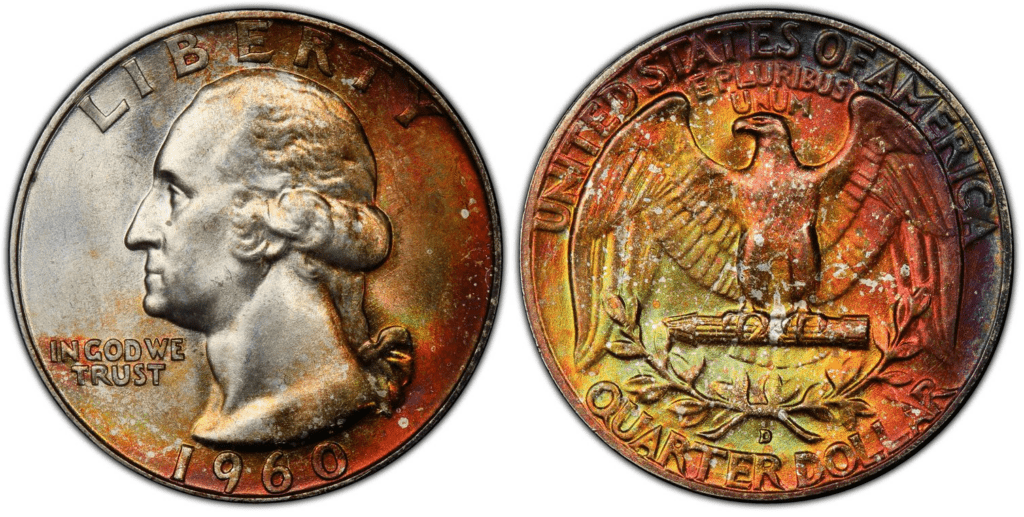
The 1960 D Washington quarter was struck in the Denver Mint. This variety is the most abundant, with more than 63 million struck quarter coins.
The price starts at around $0.25 to $12. It can be higher depending on the condition of the coin. According to numismatists, the 1960 D quarter coin is a mid-range rarity in Gem condition.
1960 P Washington Quarter
Year of minting: 1960
Mint Mark: No mint mark
Place of minting: Philadelphia
Quantity produced: 29,164,000
Face Value: $0.25 (twenty-five cent)
Price: $0.25 to $26 (or more)
Mass: 6.30 grams
Edge: Reeded
Designer: John Flanagan
Composition: 90% silver and 10% copper
Diameter: 24.3 millimeters
Thickness: 1.75 millimeters
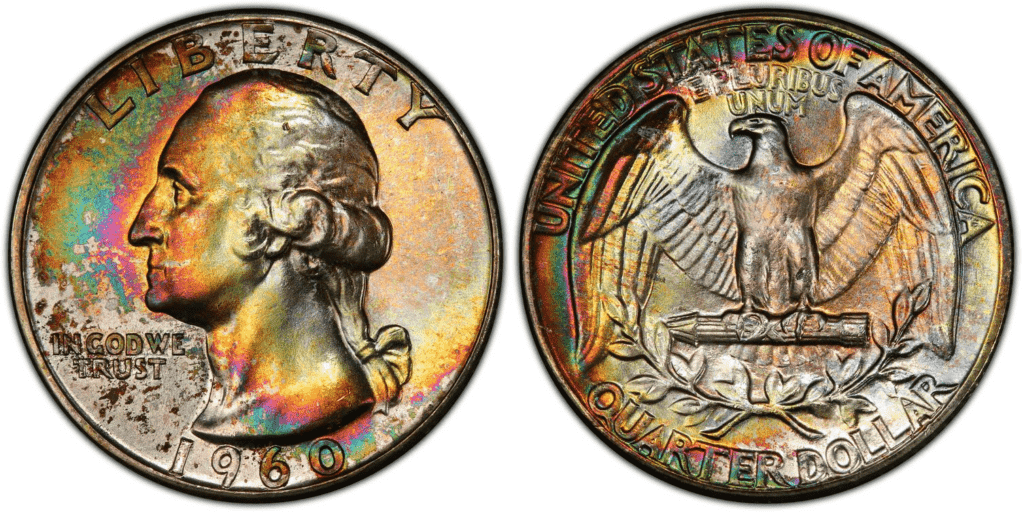
The 1960-P quarter coin was made in the Philadelphia Mint. At the end of 1960, 29,164,000 P Washington quarter coins were produced, far less than what the Denver Mint produced.
The price tag of 1960-P quarter coins may start from $0.25 and reach up to $26. If your 1960-P quarter receives a good grade, it can easily increase its value.
1960 P Proof Washington Quarter
Year of minting: 1960
Mint Mark: No mint mark
Place of minting: Philadelphia
Quantity produced: 1,691,602
Face Value: $0.25 (twenty-five cent)
Price: $0.25 to $65 (or more)
Mass: 6.30 grams
Edge: Reeded
Designer: John Flanagan
Composition: 90% silver and 10% copper
Diameter: 24.3 millimeters
Thickness: 1.75 millimeters
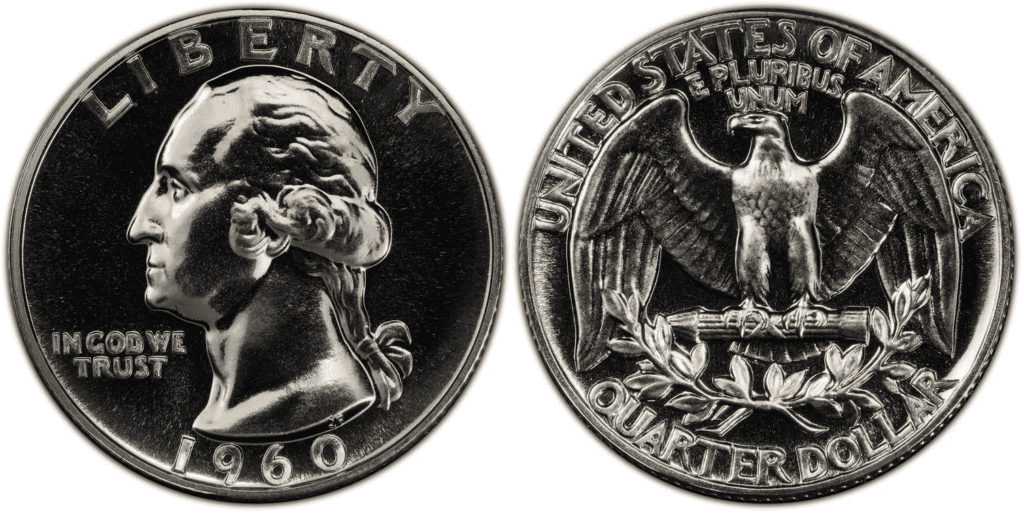
The Philadelphia Mint also produced quarter proof coins in 1960. About 1.6 million of these coins were produced, far fewer than what was produced in the Denver and Philadelphia Mint. Of course, this is understandable as proof coins are meant for collectors, not for circulation.
Proof coins are more difficult to produce. It takes more time as well. That’s why you see that only about 1.6 million of them are produced. Nevertheless, proof coins are more detailed, shinier, and attractive than regular-struck coins. Price may range from $0.25 to $65.
List of 1960 Washington Quarter Errors
With more than 93 million 1960 Washington quarter coins produced, it is not surprising to see that some of these coins had inevitably received an error. Although the US Mint has done all it could to prevent errors, there were still some instances when the 1960 quarters were struck differently.
The most common error for the 1960 Washington quarter would be the repunched mint mark or the RPM error. Remember that the Philadelphia Mint doesn’t normally add a mint mark. So, the RPM error only applies to the 1960 D quarters made in Denver.
The mint mark is supposed to be struck once. However, with RPM, the mint mark die was struck twice. This led to the mint mark having some doubling or split appearance.
Here’s an example of an RPM error on a 1960 Washington quarter coin:
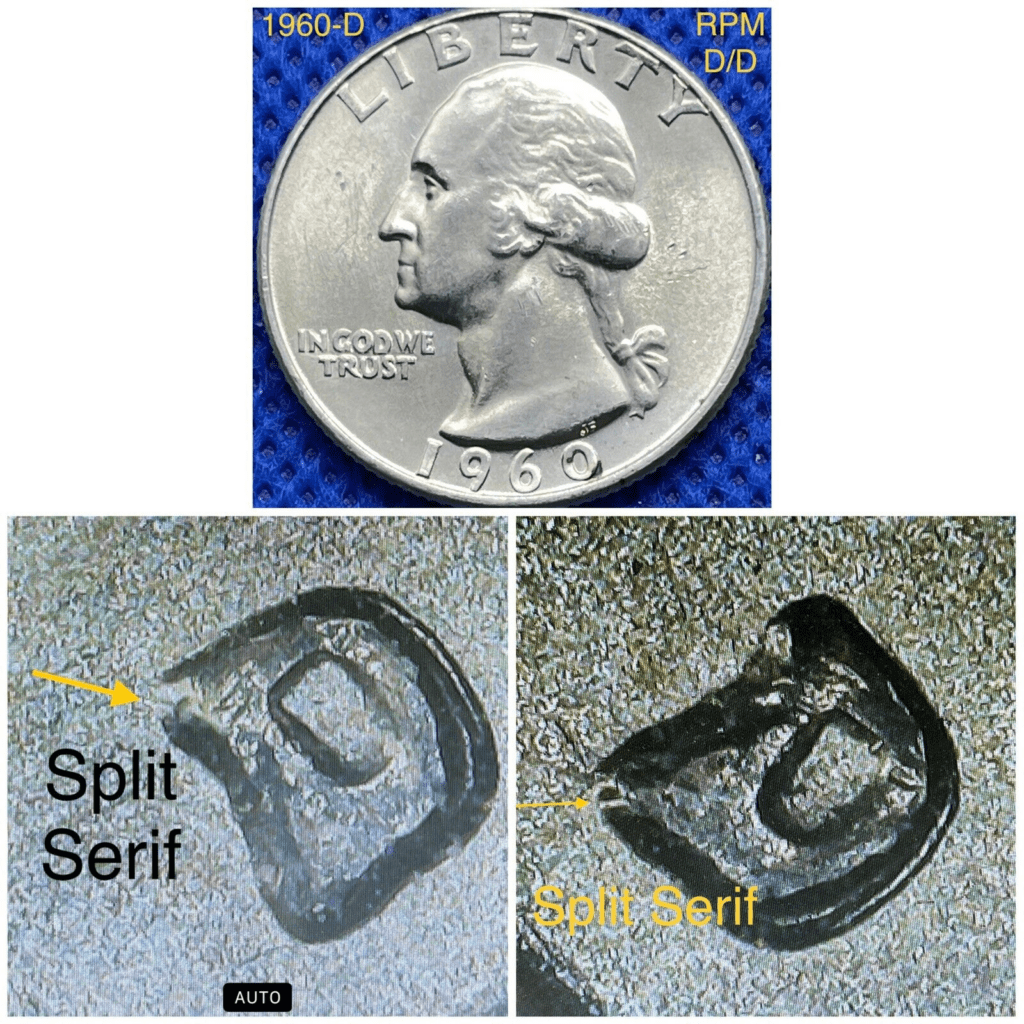
Another error that happened was the die crack error. Due to the multiple times the die hits the planchet, the die eventually becomes worn out and cracks.
When the die breaks, the crack also hits the planchet, leaving an unnecessary mark. Here’s an example of a die break error in a 1960 quarter:
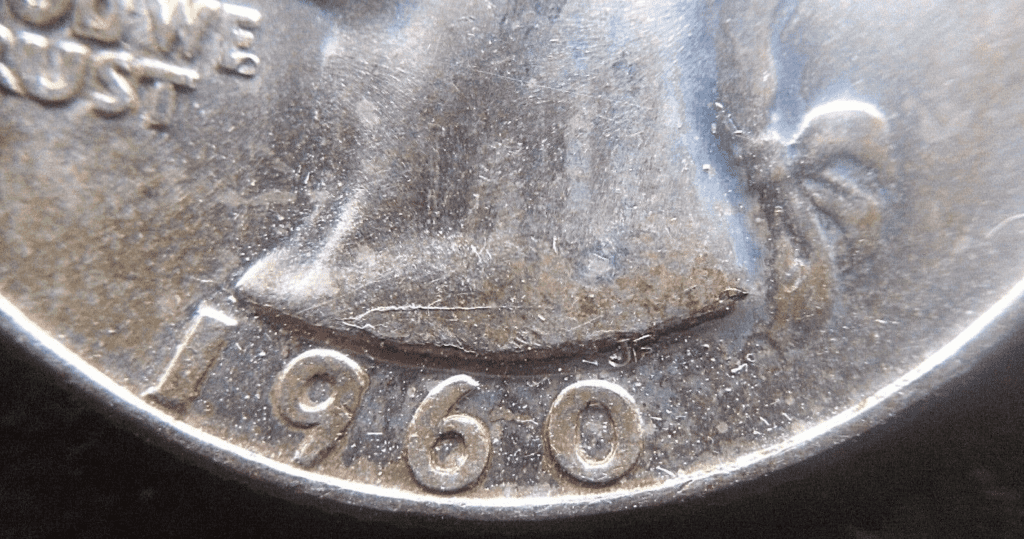
If you look at the coin close, you’ll see this line on Washington’s neck. That’s a crack on the die that has been imprinted on the coin during a strike.
Here’s an interesting example of a 1960 quarter error:
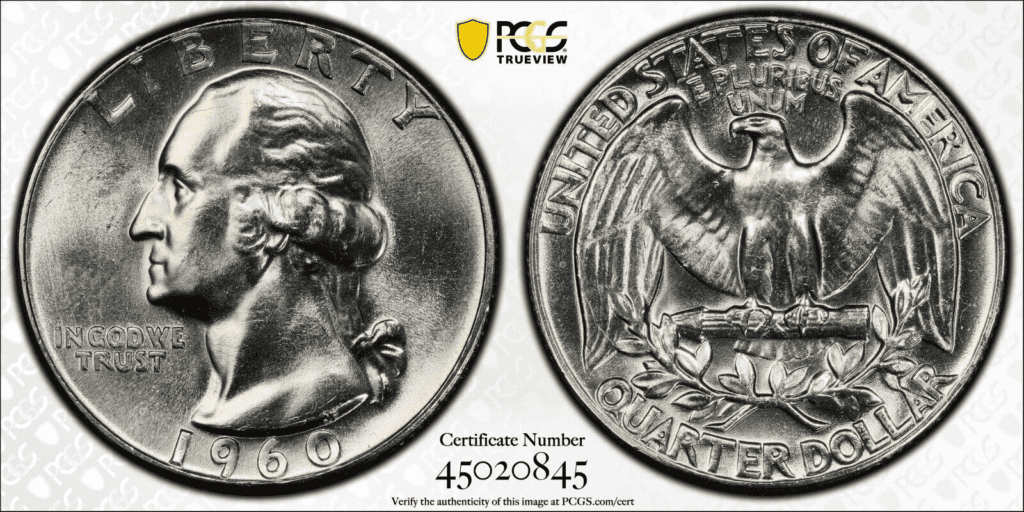
What’s so interesting about this coin is that its reverse is proof while its obverse is business struck. This is a rare error since proof coins are normally struck separately from regular coins. For this to happen, there were two types of die used.
Other errors happened during the 1960 minting process of the quarter. While they were not common errors, they still happened. Here are some of them:
- Off-center strike
- Broad strike
- Doubled die strike
- Clipped or folded planchet
- Weak strike
These errors may happen due to mechanical errors.
How Much Is the 1960 Washington Quarter Worth Today?
The 1960 Washington quarter is worth $0.25, its face value. The melt value is higher since the coin is made of silver. The melt value is $4.2246.
As this might be the case, 1960 Washington quarters are worth a lot of money. Here’s a 1960 Washington Quarter values chart to help you compare its prices:
| Coin | Condition | Grade | Mintage | Value |
| 1960 D Washington Quarter | Circulated/mint | Not graded | 63,000,324 | $0.25 to $12 |
| 1960 D Washington Quarter | Uncirculated/mint | MS-65 | 63,000,324 | $12 to $23 |
| 1960 D Washington Quarter | Uncirculated/mint | MS-66 | 63,000,324 | $20 to $1,560 |
| 1960 D Washington Quarter | Uncirculated/mint | MS-67 | 63,000,324 | $810 to $9,000 |
| 1960 P Washington Quarter | Circulated/mint | Not graded | 29,164,000 | $0.25 to $26 |
| 1960 P Washington Quarter | Uncirculated/mint | MS-65 | 29,164,000 | $11 to $32 |
| 1960 P Washington Quarter | Uncirculated/mint | MS-66 | 29,164,000 | $25 to $82 |
| 1960 P Washington Quarter | Uncirculated/mint | MS-67 | 29,164,000 | $384 to $1,680 |
| 1960 P Proof Washington Quarter | Uncirculated/mint | Not graded | 1,691,602 | $0.25 to $65 |
| 1960 P Proof Washington Quarter | Uncirculated/mint | MS-65 | 1,691,602 | $9 to $22 |
| 1960 P Proof Washington Quarter | Uncirculated/mint | MS-66 | 1,691,602 | $10 to $65 |
| 1960 P Proof Washington Quarter | Uncirculated/mint | MS-67 | 1,691,602 | $11 to $209 |
As you can see, 1960 quarter coins are astronomically more valuable than their face value. For example, according to PCGS, the auction record for the 1960 D quarter coin is $9,000. It was an MS-67 graded quarter coin sold during an auction held by Heritage Auctions in June 2019.
The auction record for the 1960 P quarter is $6,890, and for the 1960 proof quarter, it’s $550.
How Does The Grading System Work?
The Sheldon Scale is used by numismatists to provide a numerical value to coins. The Sheldon Scale goes from poor (P-1) to perfect mint state (P-1) (MS-70). Coins were originally evaluated using words to reflect their condition (Good, Fair, Excellent, Etc.). Unfortunately, coin collectors and dealers had different ideas about what each of these terms represent.
Professional numismatists joined together in the 1970s and established CoinGrading standards. These numismatists now assign grades at key places on the seventy-point scale, using the most regularly utilized numeric points in conjunction with the original adjective grade. The following are the most common coin grades:
-
-
- (P-1) Poor – Indistinguishable and probably damaged; if used, must have a date and mintmark; otherwise, rather battered.
- (FR-2) Fair – Nearly smooth, but without the damage that a coin graded Poor often possesses. The coin must have enough detail to be identified.
- (G-4) Fair – Inscriptions have merged into the rims in some areas, and important elements have been mostly erased.
- (VG-8) Very Good- A little weathered, but all of the primary design elements are visible, albeit faintly. There is little if any, central detail left.
- (F-12) Good – The item is very worn, yet the wear is even, and the overall design details stand out clearly. Rims are almost completely isolated from the field.
- (VF-20) Very Fine – Moderately weathered, with some finer features still visible. The motto or all letters of LIBERTY are readable. Both sides of the coin have entire rims that are separated from the field.
- (EF-40) Extremely Fine – Gently used; all gadgets are visible, and the most important ones are bold. The finer details are bold and clear, however, light wear may be seen.
- (AU-50) Uncirculated – Slight evidence of wear on the coin’s design’s high points; may have contact marks; eye appeal should be adequate.
- (AU-58) Uncirculated Choice – Slight traces of wear, no severe contact marks, almost full mint shine, and great eye appeal.
- (MS-60) Mint State Basal – Strictly uncirculated; no indication of wear on the coin’s highest points, but an unsightly coin with reduced luster, visible contact marks, hairlines, and other flaws.
- (MS-63) Mint State Acceptable – Uncirculated, but with contact scratches and nicks, little reduced shine, but otherwise appealing appearance. The strike is weak to average.
- (MS-65) Mint State Choice – Uncirculated with great mint shine, very little contact blemishes, and exceptional eye appeal. The strike is unusually severe.
- (MS-68) Mint State Premium Quality – Uncirculated with superb luster, no obvious contact marks to the naked eye, and exceptional eye appeal. The strike is quick and appealing.
- (MS-69) Almost Perfect Mint State – Uncirculated with perfect brilliance, a sharp and appealing strike, and extremely good eye appeal. A near-perfect coin with minor imperfections in the planchet, strike, and contact markings (seen only under 8x magnification).
- (MS-70) Mint State Perfect – Under 8x magnification, there are no tiny imperfections discernible; the strike is crisp, and the coin is perfectly centered on a beautiful planchet. Rarely seen on a coin, this coin is bright and whole, with original luster and exceptional eye appeal.
-
Where To Buy Or Sell 1960 Washington Quarter?
You can buy or sell a 1960 Washington quarter in different places. The most common place would be the Internet since it’s easy to access.
There are a lot of websites that specialize in selling and buying coins. You can do a quick Google search, and you should be able to find these specialized websites.
Aside from that, online selling platforms are a great place to search for a 1960 quarter. The most popular would be eBay. They have thousands of coins on sale. You can also try Amazon. You can also try social media.
There are brick-and-mortar stores that you can try, too. You have coin shops, antique stores, pawn shops, and auction houses.
FAQs
Is a 1960 quarter all silver?
The 1960 quarter is not all silver, although it is made of 90% silver and 10% copper.
Where is the mint mark on a 1960 quarter?
The mint mark on a 1960 quarter is on the coin’s reverse side. You should be able to find it under the olive branches or above the letter “R” of the inscription, “QUARTER DOLLAR.”
Please note that if you ever find a mint mark, it will be a letter D, which indicates the coin was made in Denver. The Philadelphia Mint doesn’t add a mint mark. So, you won’t find a P mint mark on the 1960 quarter coins.
How much is a 1960 quarter worth with no mint mark?
The 1960 quarter is worth $0.25 if you’re going to base it on its face value. However, since it is made of silver, its melt value can be as high as $4. There are also 1960 quarters which can be worth a few hundred to thousands of dollars.
Are any 1960 quarters valuable?
Some 1960 quarters are valuable, especially the ones with grades of at least MS 66 and PR 66. A 1960 quarter was even sold for $9,000 in June 2019.
